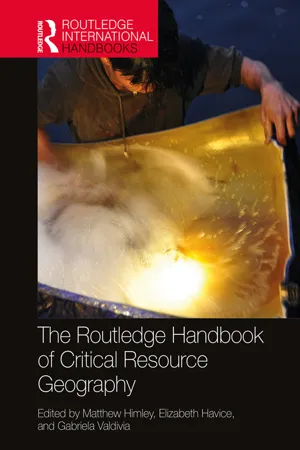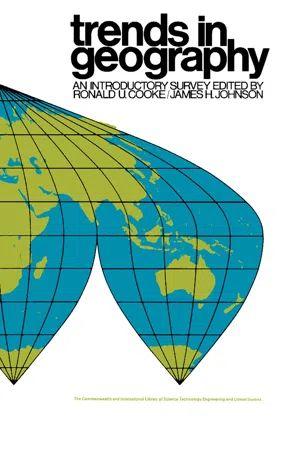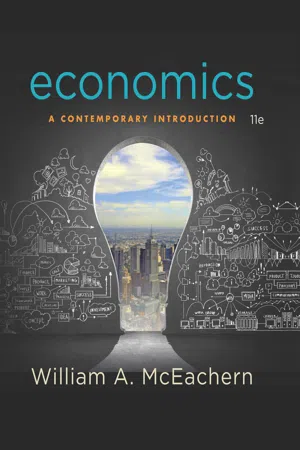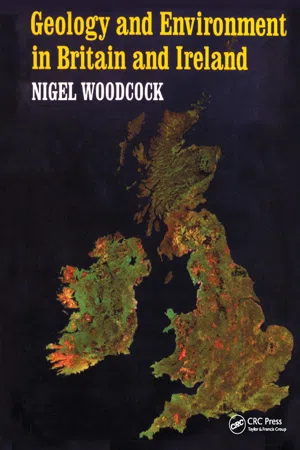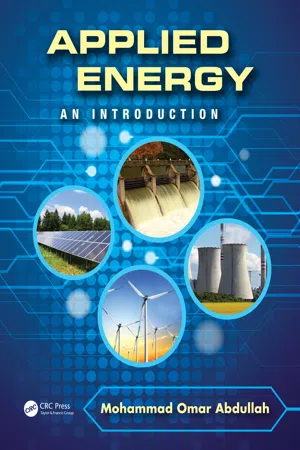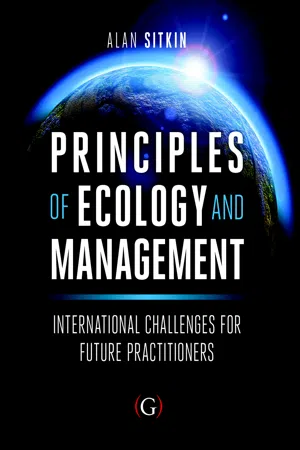Geography
Demand for Resources
Demand for resources refers to the quantity of resources that consumers are willing and able to purchase at a given price. This demand is influenced by factors such as population growth, income levels, and changes in consumer preferences. Understanding the demand for resources is important for businesses and governments in making decisions about production and allocation of resources.
Written by Perlego with AI-assistance
Related key terms
1 of 5
6 Key excerpts on "Demand for Resources"
- Matthew Himley, Elizabeth Havice, Gabriela Valdivia, Matthew Himley, Elizabeth Havice, Gabriela Valdivia(Authors)
- 2021(Publication Date)
- Taylor & Francis(Publisher)
1Critical resource geography
An introduction Gabriela Valdivia, Matthew Himley, and Elizabeth HaviceIntroduction
This Handbook is about the state of knowledge of one of geography's most cherished objects of study: resources. Resources can encompass a broad range of things, including, but not limited to, physical entities that are regularly disentangled from their existing relations and incorporated as parts or fragments within other sets of relations, in order to fulfill a promise. Resources, for example, are often thought of as means to an end, instruments to realize a goal or state, such as a life free of suffering or a “higher” level of socioeconomic development. Think of hydrocarbons extracted from the underground and refined to generate energy, or guano harvested from island ecosystems to fertilize depleted soils, or tuna captured from the oceans to meet food market demands. But resources, and the promises that they are expected to fulfill, are not simple or straightforward. Resources require systems of “resource-making” (Kama 2020; Li 2014; Richardson and Weszkalnys 2014), each with its own infrastructures, logics, temporalities, and valuation systems. Removing something from its existing relations in order to incorporate it as a resource into a new set of relations requires thought and action, all based on architectures of valuation through which some things and relations are rationalized as more valuable than others. This, in turn, raises questions about who is making these value judgments, in what context these valuations make sense and become dominant, and how systems of resource-making affect different constituencies in varied and uneven ways.The systems through which resources are made and circulated have compounding effects, shaping the world and how people experience and know it. The idea for this Handbook emerged in the context of an expansion of “critical” resource-centered scholarship examining the relationship between resource systems and the uneven worlds they create (see, for example, Bakker and Bridge 2006; Bridge 2009; Furlong and Norman 2015; Huber 2018; Lawhon and Murphy 2012; Kama 2020; Robbins 2002). Broadly, this research coheres around three key elements: an approach that positions the resource itself as the analytical starting point; an emphasis on the interrelated materiality and spatiality of resources and resource systems; and a concern for unequal power relations, distributive outcomes, and the ethical dimensions of these systems. Thematically, the focus is often on the capitalist production, distribution, and consumption of “established” resources—that is, entities whose identities as resources are relatively well-consolidated (e.g., copper, oil, tuna)—as well as the emergence of new socio-spatial “frontiers” for these, as seen, for instance, in the march of hydrocarbon and mineral-mining operations offshore and into deeper waters. Scholars also examine how an increasing array of things-in-the-world are abstracted, monetized, and incorporated into social life as “novel” resources or in resource-like ways: things such as human tissues, wildlife, parasites, and ecosystem services. Across this body of scholarship, researchers are attentive to the contestations and crises—from climate change to species extinction to toxic contamination—that are generated by dominant (i.e., capitalist) modes of resource production, consumption, management, and disposal. And scholars are increasingly interested in resource futures (e.g., green transitions and degrowth) as well as worlds that exist (or might exist) without or against the notion of resources.- eBook - PDF
Trends in Geography
An Introductory Survey
- Ronald U. Cooke, James H. Johnson, Ronald U. Cooke, James H. Johnson(Authors)
- 2013(Publication Date)
- Pergamon(Publisher)
C H A P T E R 15 NEW RESOURCE EVALUATIONS G. MANNERS RESOURCE EVALUATION AND THE GEOGRAPHER A burgeoning world population, together with the quickening pace of economic and technological development, are making increasing demands upon the natural resources available to man. Although a serious long-term shortage of the major metals or conventional fossil fuels has yet to occur, the persistent growth in global requirements for such materials as iron ore, bauxite copper, tin, oil, and natural gas—plus occasional local scarcities—inevitably raise questions concerning their future adequacy. It is a matter of such funda-mental importance at all stages and scales of economic development, that the thorough and recurrent investigation of resource availabilities has become an economic and political imperative. Geographers have perennially laid great stress upon the importance and the quality of nature's endowments, and of man's selective—if at times indis-criminate—use of them. Consequently one might have expected that a lively discussion of resource availabilities would figure prominently in their literature. Yet evaluative judgements concerning the size and the quality of natural resources in general, and of mineral and energy resources in particular, are remarkably elusive in geographical writings. The received opinions of geologists and mining engineers concerning such endowments have been readily embraced, but the perceptive interpretation of their partial conclusions in the light of the spatial, economic, and other constraints upon resource use has been conspicuously absent. These constraints must be accorded full recognition in any complete appraisal of a resource, for without them a discussion of its size and worth can lead to a gross misinterpretation of its significance. - eBook - PDF
Economics
A Contemporary Introduction
- William A. McEachern(Author)
- 2016(Publication Date)
- Cengage Learning EMEA(Publisher)
Resource Markets 11 • Why do truck drivers in the United States earn at least 20 times more than bicycle-rickshaw drivers in India? • Why do surgeons earn twice as much as general practitioners? • Why does prime Iowa corn acreage cost more than scrubland in the high plains of Montana? • Why might a broadband Internet connection boost some wages and depress others? • Why are buildings in downtown Chicago taller than those in the suburbs and taller than those in downtown Phoenix? • How might higher gas prices reduce obesity? To answer these and other questions, we turn to the demand and supply of resources. Robert Carner/iStockphoto.com Copyright 2017 Cengage Learning. All Rights Reserved. May not be copied, scanned, or duplicated, in whole or in part. Due to electronic rights, some third party content may be suppressed from the eBook and/or eChapter(s). Editorial review has deemed that any suppressed content does not materially affect the overall learning experience. Cengage Learning reserves the right to remove additional content at any time if subsequent rights restrictions require it. 245 Y ou say you’ve been through this demand-and-supply drill already? True. But the earlier focus was on product markets—that is, on markets for final goods and services. Goods and services are produced by resources—labor, capital, natural resources, and entrepreneurial ability. Demand and supply in resource markets determine the price and quantity of resources. And the ownership of resources determines the distri- bution of earnings throughout the economy. Because your earnings depend on the market value of your resources, you should find this chapter on resource markets particularly relevant to your future. Certainly, one consideration in your career choice is the expected earnings associated with alternative careers. The next three chapters examine how demand and supply interact to establish market prices for various resources. - Nigel Woodcock(Author)
- 2017(Publication Date)
- CRC Press(Publisher)
Further reading McLaren, D.J. & B.J.Skinner 1987. Resources and world development. Chichester: John Wiley. [Contains several informative chapters on resource assessment in general, as well as much material on individual commodities.] Geology and environment in Britain and Ireland 56 Meadows, D.H., D.L.Meadows, J.Randers, W.W. Behrens 1972. The limits to growth. New York: Universe. [A Malthusian view of the future resource crisis, and the catalyst for a large later literature.] Myers, N. (ed.) 1985. The Gaia atlas of planet management. London: Pan. [The first of many popular graphic compilations of data on world resources.] Pearce, D.W. & R.K.Turner 1990. Economics of natural resources and the environment. New York: Harvester Wheat-sheaf. [A detailed analysis of resource economics.] Skinner, B.J. 1969. Earth resources. Englewood Cliffs, NJ: Prentice-Hall. [A useful introduction to geological resources.] Simmons, I.G. 1991. Earth, air and water: resources and environment in the late 20th century. London: Edward Arnold. [A clear and valuable introduction to the changing rôle of resources in society.] World Commission on Environment and Development 1987. Our common future. Oxford: Oxford University Press. [An influential analysis of prospects for global sustainable development.] World Resources Institute 1992. World resources 1992–93. Oxford: Oxford University Press. [A biannual compilation of data and analysis on human and natural resources.] Worldwatch Institute 1992 [and annually]. State of the World 1992. London: Earthscan. [An annual report on “progress towards a sustainable society”, including readable analyses of natural resources.] Resources 57 Chapter Six LAND 6.1 Land as a resource Land is a fundamental natural resource, but one of the most difficult to assess and use wisely. Land is naturally so variable and is used by society in so many different ways.- eBook - PDF
Applied Energy
An Introduction
- Mohammad Omar Abdullah(Author)
- 2012(Publication Date)
- CRC Press(Publisher)
3 Energy Resources, Supply, and Demand In this chapter, we will cover and examine one of the most fundamental aspects of energy application, in relation to the following elements: • Energy resources; • Energy supply; and • Energy demand. Also, we see the relationships between the elements as well as their importance to our energy applications — as a which influences our worldwide energy application scenarios. 3.1 Introduction to Energy Resources, Supply, and Demand Our energy resources, energy supply, and energy demand can be represented by the optimistic, balanced plots shown in Figure 3.1. It is a general trend that, over the years, as total energy demand increases due to our daily energy requirements, total energy supply also increases in order to meet those demands. ∗ Y ear Total energy Energy resources Energy supply Energy demand Figure 3.1 The interrelation of energy resources, energy supply, and energy demand based on optimistic, balanced total energy application (OBTE) scenarios. ∗ It is to be noted that the plot of total energy resources is also shown increasing year by year rather than as a fixed plateau; this does not violate the energy conservation laws as outlined in Chapter 1. The total amount of energy in the earth’s system remains unchanged, that is, theoretically, it is the total net available energy reserves that decrease with time (see Section 3.2.2). 79 80 Applied Energy: An Introduction 3.2 Energy Resources 3.2.1 What Is Energy Resources? Energy resources is a term used to define ways of getting energy for our energy applications. Our world’s energy resources basically have close links with the sun, which travels marvelously and consistently around the globe, as a result of which the sun also contributes useful rays and the associated energy on the earth. - eBook - PDF
- Alan Sitkin(Author)
- 2011(Publication Date)
- Goodfellow Publishers(Publisher)
Energy inputs There is a good argument that the main interface between economy and ecology resides in the power that humankind derives from natu-ral resources (Monbiot 2007). Two crucial factors in this relationship are technology and above all population size. In older agricultural economies, most energy involved ‘current sunlight’, with people either eating plants nourished via photosynthesis (see Chapter 1) using them for building materials, or feeding them to animals that could be used for food or clothing (Hartmann 2004). As technological know-how advanced to allow humankind to access ‘ancient sunlight’ stored in the form of fossil fuels derived from the accumulation of dead plants, people were able to source much greater quantities of energy. This led to demographic growth, however the larger populations that ensued could only be sustained by tapping into energy resources above and beyond those provided by current sunlight, i.e. by drawing upon fossil fuel reserves that are by definition finite in nature and will therefore be necessarily exhausted after x years of extraction and consumption. When this occurs, only the very few ‘Earth ships’ that are self-sufficient in power generation (Freney 2009) will be unaffected. Conversely, the vast majority of actors who rely on external sources of power will have to adapt. Of course, the scenario should also mean greater demand for the services of those companies that specialise in the supply of energy Demography: Study of population patterns (birth rates, mortality, migration, etc.) Are there too many ? people on Earth? Resource Depletion 31 2 – something that students currently considering their career prospects may wish to bear in mind. Global supply/demand scenarios Some factors affecting the future of global energy are specific to this one field.
Index pages curate the most relevant extracts from our library of academic textbooks. They’ve been created using an in-house natural language model (NLM), each adding context and meaning to key research topics.
